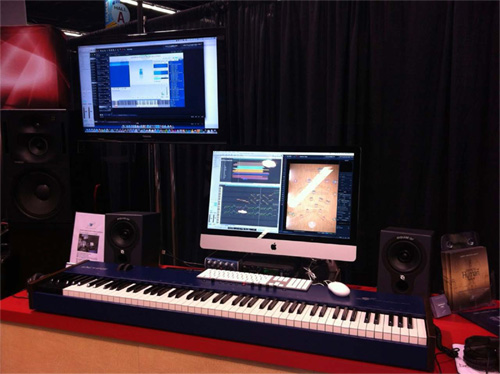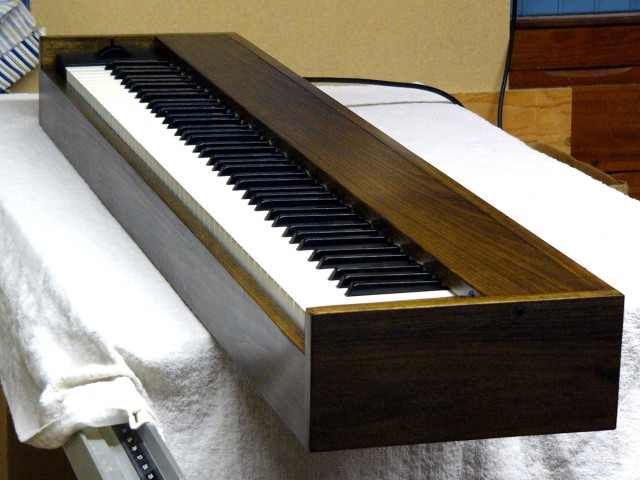timfrost91
Member
- Joined
- Apr 2, 2016
- Messages
- 10
Hi Everyone
Over the coming months, I would like to design and build a full sized (88 Key) midi controller, designed to imitate the true feel of a high quality grand piano piano action (within reason of course, but as closely as possible). There is already a highly acclaimed midi controller by Kawai on sale right now, the VPC-1, which is well known as 'the midi controller of choice' for pianists seeking a grand piano-esque action. It would fit my needs perfectly, however here in the UK it is £1000, which just seems an awful lot to pay for a piece of gear that doesn't even do anything productive until it's connected to a computer! Please can anyone advise me on whether it is realistic to try and build a midi controller of similar quality to the VPC-1 for around half the price?
The two critical elements of the project will be: (1) the sensor system/electronics and (2) the action. For the sensors, there are many options available, and choosing the right one will be key. Cheap non-velocity sensitive beginner keyboards tend to have a single contact sensor, hence can only play any note at a single identical volume, no matter how hard the keys are struck. Most higher quality stage pianos and midi controllers tend to use a double contact sensor system. I could be wrong, but I believe these systems work using two protruding pieces of plastic underneath every key of slightly different lengths. As 'prong 1' and 'prong 2' under each key are slightly different in length, this creates a time delay between the points at which the rubber contact sensors are struck, which is translated to velocity midi information i.e. the harder the key is pressed, the shorter the delay between prong 1 and prong 2 contacting their respective sensors. However, double sensor systems are poor at playing
very fast repeated notes, which limits their capabilities in many respects. For this reason The VPC-1, and a few other higher end piano controllers use a triple sensor system, where an additional 'middle sensor' is added. This means the controller has the ability to replicate a grand piano more realistically for fast repeated notes - in a triple sensor system the key prongs only have to return to above the middle sensor, (not to above the top sensor) before the same key can be replayed. A triple sensor system like this far more closely mimics the action of a grand piano, which has a repetition lever designed to allow the hammers to play very fast repeated notes (some pianists claim up to 12 per second!).
Triple sensor systems like that used in the Kawai VPC-1 are undoutedly much better for fast repeated notes, however the reasoning as to why they are baffles me in many ways - the top sensor is surely useless for these fast repeated notes, so why can't the 'top' sensor in a triple sensor system simply be eliminated altogether, leaving a better double sensor system with sensors closer to the bottom (full depression) of each key? This would still allow fast repeated notes, no? Perhaps I am missing something obvious and someone could shed some light on why this isn't possible.
In addition to contact sensors, there is also the option of using a pressure rather than velocity based system, for example Force Sensitive Resistors under each key as shown in a rudimentary proof of concept fashion on YouTube using 'velostat https://www.youtube.com/watch?v=nmIXKrA4-UA'. There is also the option of using some kind of LED/light based optical system, as shown in this proof of concept article: http://hackaday.com/2010/10/07/playing-piano-with-optical-sensors/ which following this article I believe was subsequently turned into a commercial product, or at least attempted to be: https://sebion.wordpress.com/posts/
Which sensor system in a DIY project do you think would provide the best results? (Contact vs Pressure (FSR) vs Optical (LED))
The electronics and sensor system is the hardest part of the project to get right, but when it comes to other element of the project, the action, there is still a lot to consider. I would like to build a fairly quiet weighted and 'graded' (meaning bass notes have slightly more resistance than treble notes due to the thicker strings at the bottom end of a real piano, so they are weighted slightly more heavily at the bottom end) hammer action with full length key sticks, of a length similar to the length of those used in the Kawai MP11 Stage Piano's 'Grand Feel action (an all but identical action to the RMIII action used in the VPC-1, with the only slight difference (improvement) being the keysticks are around 1" longer, giving a slightly more realistic feel (easier depression with the same force) further up the keys). It would also be nice to feature "let-off" a very subtle resistance in the action part way down the key depression at very soft velocities, although this not essential as it is a very subtle effect and not noticeable during normal playing. There is a very good clickable animation here: http://www.kawaivpc.com/en/features/, which illustrates the grey mechanical rubber "let-off" mechanism in the top left, together with the grey triple contact system at the back of the key. It also shows the positioning of the balance pins, hammer system, and padding very clearly.
Any advice on this project would be much appreciated as I am still very much in the early days.
Over the coming months, I would like to design and build a full sized (88 Key) midi controller, designed to imitate the true feel of a high quality grand piano piano action (within reason of course, but as closely as possible). There is already a highly acclaimed midi controller by Kawai on sale right now, the VPC-1, which is well known as 'the midi controller of choice' for pianists seeking a grand piano-esque action. It would fit my needs perfectly, however here in the UK it is £1000, which just seems an awful lot to pay for a piece of gear that doesn't even do anything productive until it's connected to a computer! Please can anyone advise me on whether it is realistic to try and build a midi controller of similar quality to the VPC-1 for around half the price?
The two critical elements of the project will be: (1) the sensor system/electronics and (2) the action. For the sensors, there are many options available, and choosing the right one will be key. Cheap non-velocity sensitive beginner keyboards tend to have a single contact sensor, hence can only play any note at a single identical volume, no matter how hard the keys are struck. Most higher quality stage pianos and midi controllers tend to use a double contact sensor system. I could be wrong, but I believe these systems work using two protruding pieces of plastic underneath every key of slightly different lengths. As 'prong 1' and 'prong 2' under each key are slightly different in length, this creates a time delay between the points at which the rubber contact sensors are struck, which is translated to velocity midi information i.e. the harder the key is pressed, the shorter the delay between prong 1 and prong 2 contacting their respective sensors. However, double sensor systems are poor at playing
very fast repeated notes, which limits their capabilities in many respects. For this reason The VPC-1, and a few other higher end piano controllers use a triple sensor system, where an additional 'middle sensor' is added. This means the controller has the ability to replicate a grand piano more realistically for fast repeated notes - in a triple sensor system the key prongs only have to return to above the middle sensor, (not to above the top sensor) before the same key can be replayed. A triple sensor system like this far more closely mimics the action of a grand piano, which has a repetition lever designed to allow the hammers to play very fast repeated notes (some pianists claim up to 12 per second!).
Triple sensor systems like that used in the Kawai VPC-1 are undoutedly much better for fast repeated notes, however the reasoning as to why they are baffles me in many ways - the top sensor is surely useless for these fast repeated notes, so why can't the 'top' sensor in a triple sensor system simply be eliminated altogether, leaving a better double sensor system with sensors closer to the bottom (full depression) of each key? This would still allow fast repeated notes, no? Perhaps I am missing something obvious and someone could shed some light on why this isn't possible.
In addition to contact sensors, there is also the option of using a pressure rather than velocity based system, for example Force Sensitive Resistors under each key as shown in a rudimentary proof of concept fashion on YouTube using 'velostat https://www.youtube.com/watch?v=nmIXKrA4-UA'. There is also the option of using some kind of LED/light based optical system, as shown in this proof of concept article: http://hackaday.com/2010/10/07/playing-piano-with-optical-sensors/ which following this article I believe was subsequently turned into a commercial product, or at least attempted to be: https://sebion.wordpress.com/posts/
Which sensor system in a DIY project do you think would provide the best results? (Contact vs Pressure (FSR) vs Optical (LED))
The electronics and sensor system is the hardest part of the project to get right, but when it comes to other element of the project, the action, there is still a lot to consider. I would like to build a fairly quiet weighted and 'graded' (meaning bass notes have slightly more resistance than treble notes due to the thicker strings at the bottom end of a real piano, so they are weighted slightly more heavily at the bottom end) hammer action with full length key sticks, of a length similar to the length of those used in the Kawai MP11 Stage Piano's 'Grand Feel action (an all but identical action to the RMIII action used in the VPC-1, with the only slight difference (improvement) being the keysticks are around 1" longer, giving a slightly more realistic feel (easier depression with the same force) further up the keys). It would also be nice to feature "let-off" a very subtle resistance in the action part way down the key depression at very soft velocities, although this not essential as it is a very subtle effect and not noticeable during normal playing. There is a very good clickable animation here: http://www.kawaivpc.com/en/features/, which illustrates the grey mechanical rubber "let-off" mechanism in the top left, together with the grey triple contact system at the back of the key. It also shows the positioning of the balance pins, hammer system, and padding very clearly.
Any advice on this project would be much appreciated as I am still very much in the early days.
























![Electronics Soldering Iron Kit, [Upgraded] Soldering Iron 110V 90W LCD Digital Portable Soldering Kit 180-480℃(356-896℉), Welding Tool with ON/OFF Switch, Auto-sleep, Thermostatic Design](https://m.media-amazon.com/images/I/41gRDnlyfJS._SL500_.jpg)









